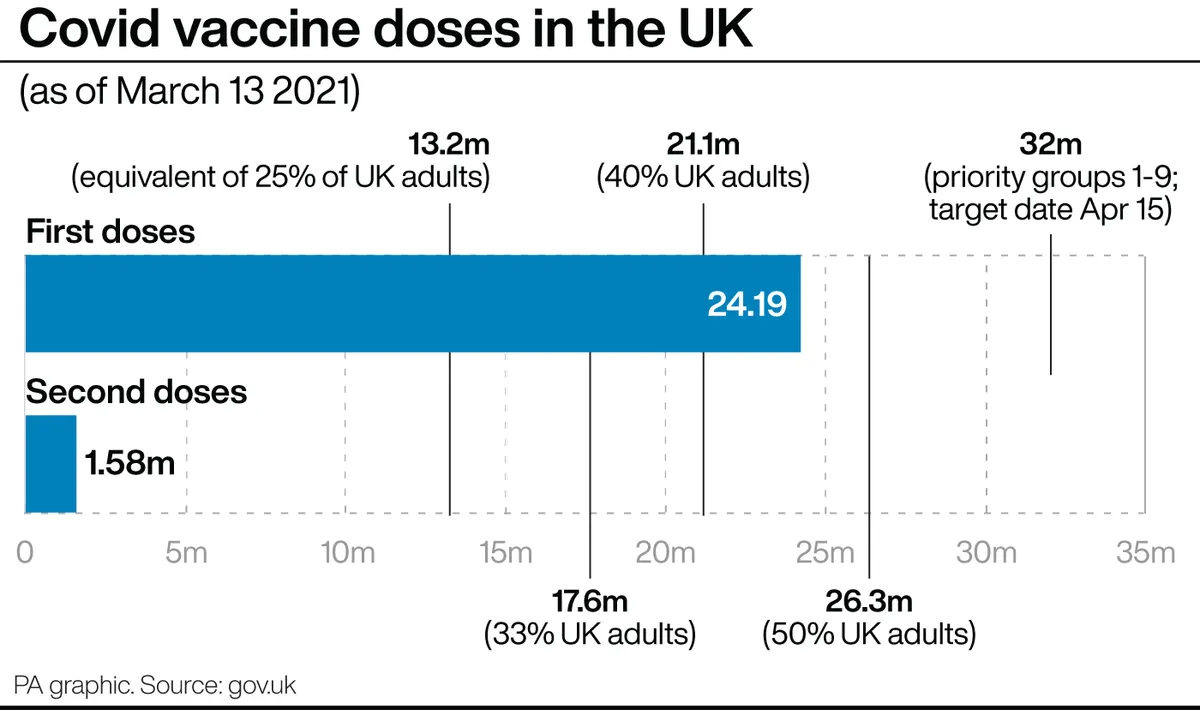Receiving two doses of either the Pfizer/BioNTech or Oxford/AstraZeneca vaccine offers similar protection against coronavirus as natural immunity after infection, at study carried out at the University of Oxford suggests.
The researchers found that none of the 1,456 healthcare workers at Oxford University Hospitals (OUH) NHS Foundation Trust who had received two doses of vaccine had a symptomatic infection when followed up 14 days or more after their second dose.
They also found 98 per cent fewer symptomatic infections in unvaccinated healthcare workers who had contracted COVID-19 naturally, when compared to unvaccinated individuals.
Read more about coronavirus:
- Can we stop the spread of more coronavirus variants?
- Bristol variant could infect people who have been vaccinated
- Moderna vaccine ‘effective against new variants’
The study, which has not been peer-reviewed, is published on the MedRxiv pre-print server.
In total, 13,109 OUH healthcare workers participated in the study, with 11,023 receiving at least one dose of vaccine.
Of these, 8,285 received the Pfizer/BioNTech vaccine, with 1,407 of them receiving two doses, and 2,738 received the Oxford/AstraZeneca jab, with 49 of them receiving two doses.
“We are grateful to the thousands of staff who work at OUH’s hospitals who have taken part in the testing programme,” said Dr Katie Jeffery, OUH director of infection prevention.
“It has provided a rich source of data that continues to shed light on the nature of this new virus and how immunity to it is conferred.
“In this case it is significant that two doses of the vaccines offer similar levels of protection to natural immunity, and that we saw no symptomatic infections among those staff who had had two vaccine doses.”

“Data from studies such as this are important as they provide information which may feed into national policy. It also highlights that healthcare workers and other groups at increased risk of infection should take up second vaccines as soon as these are available,” said Jeffrey.
The researchers also found no evidence that either the vaccines or natural infection provided less protection against the Kent variant of the virus.
The research also suggests both vaccination and previous infection may reduce transmission, after finding that the rate of positive tests was lower after both.
And even when people did get infected after a previous infection there was evidence the amount of virus present was reduced, making transmission less likely, the researchers say.
How do scientists develop vaccines for new viruses?
Vaccines work by fooling our bodies into thinking that we’ve been infected by a virus. Our body mounts an immune response, and builds a memory of that virus which will enable us to fight it in the future.
Viruses and the immune system interact in complex ways, so there are many different approaches to developing an effective vaccine. The two most common types are inactivated vaccines (which use harmless viruses that have been ‘killed’, but which still activate the immune system), and attenuated vaccines (which use live viruses that have been modified so that they trigger an immune response without causing us harm).
A more recent development is recombinant vaccines, which involve genetically engineering a less harmful virus so that it includes a small part of the target virus. Our body launches an immune response to the carrier virus, but also to the target virus.
Over the past few years, this approach has been used to develop a vaccine (called rVSV-ZEBOV) against theEbola virus. It consists of a vesicular stomatitis animal virus (which causes flu-like symptoms in humans), engineered to have an outer protein of the Zaire strain of Ebola.
Vaccines go through a huge amount of testing to check that they are safe and effective, whether there are any side effects, and what dosage levels are suitable. It usually takes years before a vaccine is commercially available.
Sometimes this is too long, and the new Ebola vaccine is being administered under ‘compassionate use’ terms: it has yet to complete all its formal testing and paperwork, but has been shown to be safe and effective. Something similar may be possible if one of the many groups around the world working on a vaccine for the new strain ofcoronavirus(SARS-CoV-2) is successful.
Read more: